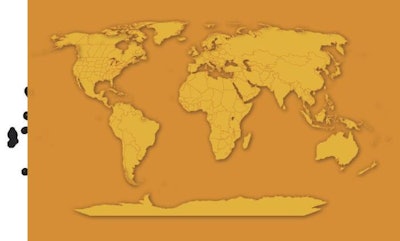
We have just finished a study in which the cost of producing pigs in 4 countries of eastern Europe Hungary, Romania, Ukraine and Russia were compared with a situation in the Netherlands where the average cost per kilogram slaughter weight in 2006 was €1.11 excluding value-added tax (VAT). The costs were lower than this in each of the places examined. By our calculations the production cost in Hungary and Romania was equivalent to 0.97/kg liveweight or 1.05/kg carcase. In Russia and Ukraine it was even less, at approximately 0.80/kg slaughter weight.
These costs are based on a manager from the west actually working on-site rather than from a distance. This yields a cost advantage of €0.20-0.30 per kilogram. Consequently, farm profitability can readily be increased by deploying a manager from the Netherlands or other western countries.
It was one of the conclusions from the study, undertaken when our institute LEI was asked by the Ministry of Agriculture, Nature and Food Quality together with companies Cehave/Landbouwbelang and Van Rooi Meat to look at investing in the pig supply chain of eastern Europe from a Dutch perspective. Increases in scale and restrictive national measures have recently persuaded various Dutch companies from the pork sector to search for opportunities for expansion outside the Netherlands. Although members of the feed and breeding sector have taken the lead in this respect, a number of pig producers also are interested in investing abroad.
Hungary, Romania, Ukraine and Russia share the characteristic that agriculture plays an important role in their country.
But the countries differ in terms of their politics, economic position, expected potential for pork production and the associated risks.
The structure of the production sector differs from that in western Europe, because family farms do not play any significant role. Demographic developments, the abolition of direct subsidies and increases of scale in the meat industry will probably result in a further decrease in the number of pigs kept by micro farms.
Hungary: The Hungarian pig sector is threatened with further contraction. Opportunities for investments are available to foreign pig producers deploying a combination of expertise, good management and the utilisation of benefits offered by the location to compete with local farmers. Those benefits in Hungary are space, low disease pressure, the country's central location in Europe and also its reasonable standard of living and social security provisions.
Romania: Romania is making up the lost ground in the standard of living, increases in scale, chain development and quality standards. The meat industry includes a number of major players who are still in development. Local processing of meat products is in part dependent on imports.
The production sector offers scope for family farms, provided that the risk of animal diseases is restricted. Romania is currently unable to export meat due to outbreaks of swine fever. It has a sufficient supply of animal feed materials and favourable access to sea ports. But the production of compound feeds is still in its infancy.
Ukraine: Ukraine offers major opportunities for agriculture, although these are still virtually unexplored. Labour is cheap and, upon improved utilisation of the land achieved by irrigation, plenty of cheap animal feed would be available.
The consumption of pork is also increasing. The meat industry — which is in part supported by imported meat — receives assistance in the form of tax benefit zones.
Russia: Russian demand for pork is growing quickly due to the rapid development of purchasing power and political support. Major investments are being made, especially with capital from outside the agricultural sector, whereby investors are supported by western knowledge and management. Making investments from abroad is not simple. However, the country welcomes input in the form of managers, knowledge and knowledge-intensive products (such as feed premixes, pig-house design and management support systems).
Investors need to have in-house funds at their disposal for investments in Eastern Europe, since it is virtually impossible to obtain loans in these countries and any loans that can be obtained are very expensive. One possibility for people in the Netherlands would be a combination of Dutch and Eastern European operations. This option could be advantageous in view of the distribution of risks and the availability of capital: the investor's own funds are allocated to the foreign operations, while the Dutch ones rely more on borrowed capital.
In view of the lengthy permit procedures required for completely new units, a more favourable option will often be to modernise existing farms. Such an approach also offers an opportunity to explore the local market and generate support among the local population. Investment in a partial interest in existing businesses is recommended, certainly when entering unknown markets, since partial investments limit the risk and provide access to local networks.
It is conceivable that local producers will be more inclined to opt for finishing pig production. Consequently, western-oriented farms in Eastern Europe could produce piglets, to supply local finishing enterprises.
From our study, it is one of a wealth of opportunities offered by these 4 countries to participants in the Dutch pig-supply chain. PIGI















